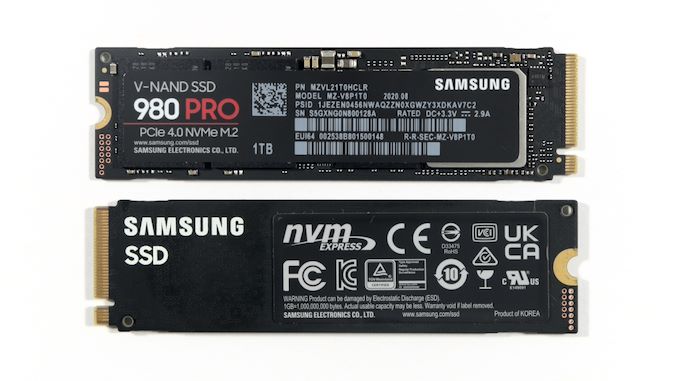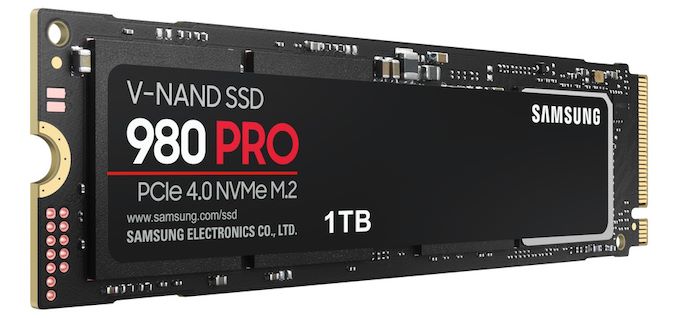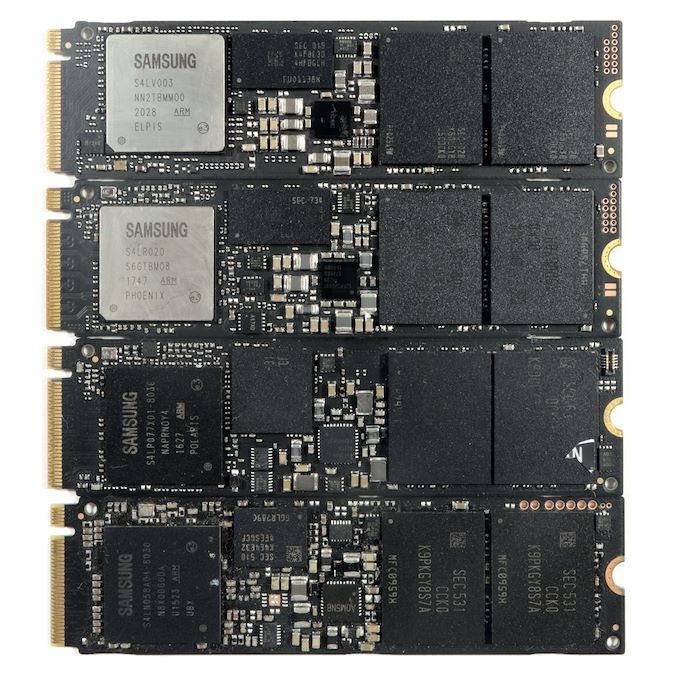The Samsung 980 PRO PCIe 4.0 SSD Review: A Spirit of Hope
by Billy Tallis on September 22, 2020 11:20 AM EST
It may be a bit later than originally planned, but Samsung's first consumer SSD to support PCIe 4.0 is here. The Samsung 980 PRO was first previewed at CES in January, but we didn't hear anything further until leaks started appearing towards the end of summer. Now the 980 PRO is set to kick off a new wave of PCIe 4.0 SSD releases. These new changes are the most significant changes to Samsung's PRO SSD line since the debut of its first NVMe drive.
The Samsung 980 PRO PCIe 4.0 SSD
As we march onto a world where PCIe 4.0 is going to start being offered to the vast majority of consumers in all segments of computing, the move is on in order to enable support for these new standards. Benefits such as increased peak speed, or decreased power consumption, are obvious vital specifications that PCIe 4.0 brings to the table, and thus having optimized products to go along with it has always been the case as new generations trump the told. Samsung's first PCIe 4.0 x4 offering for consumers is the 980 PRO, a series of M.2 drives with capacities up to 2.0 TB.
These new drives feature the latest in Samsung's controller design, but also mark the change from 2-bit cells to 3-bit cells for the Pro line of drives. This creates changes for increased capacity and decreased cost, and due to Samsung's controller technology the lower theoretical endurace we might expect with TLC is still covered by the warranty. Samsung's Pro line of storage drives have always been designed to impress, always being in the upper echelons for performance for the market. This is what we're here to test in this review.
| Samsung 980 PRO SSD Specifications | ||||||
| Capacity | 250 GB | 500 GB | 1 TB | 2 TB | ||
| Interface | PCIe 4 x4, NVMe 1.3c | |||||
| Form Factor | M.2 2280 Single-sided | |||||
| Controller | Samsung Elpis | |||||
| NAND | Samsung 128L 3D TLC | |||||
| LPDDR4 DRAM | 512MB | 1GB | 2GB | |||
| SLC Write Cache Size |
Min | 4 GB | 4 GB | 6 GB | TBD | |
| Max | 49 GB | 94 GB | 114 GB | |||
| Sequential Read | 6400 MB/s | 6900 MB/s | 7000 MB/s | |||
| Sequential Write | SLC | 2700 MB/s | 5000 MB/s | 5000 MB/s | ||
| TLC | 500 MB/s | 1000 MB/s | 2000 MB/s | |||
| Random Read IOPS (4kB) |
QD1 | 22k | 22k | 22k | ||
| Max | 500k | 800k | 1000k | |||
| Random Write IOPS (4kB) |
QD1 | 60k | 60k | 60k | ||
| Max | 600k | 1000k | 1000k | |||
| Active Power | Read | 5.0 W | 5.9 W | 6.2 W | ||
| Write | 3.9 W | 5.4 W | 5.7 W | |||
| Idle Power | APST | 35 mW | ||||
| L1.2 | 5 mW | |||||
| Write Endurance | 150 TB 0.3 DWPD |
300 TB 0.3 DWPD |
600 TB 0.3 DWPD |
1200 TB 0.3 DWPD |
||
| Warranty | 5 years | |||||
| Launch MSRP | $89.99 (36¢/GB) |
$149.99 (30¢/GB) |
$229.99 (23¢/GB) |
TBD | ||
Today we are testing the 250 GB and 1 TB models, representing the current minimum and maximum of what is on offer. The 2 TB model is set to come to retail at a later date, along with its respective specifications.
Two Waves of PCIe 4.0 Storage: Wave One
AMD kicked off the transition to PCIe 4.0 last year with the release of their Zen 2 family of CPUs. This started the first phase of PCIe 4.0 SSDs, starting with Phison.
Phison was the only SSD controller vendor ready with a PCIe 4.0 solution at the time; its E16 controller has enjoyed over a year on the market as the only option for consumer PCIe 4.0 SSDs. We're reported a lot about it as well. But the Phison E16 was a bit of a rushed design, with a minimum of changes to their highly successful E12 controller to enable PCIe 4.0 support. That left the E16 with some notable shortcomings: it only offers slightly more peak bandwidth provided by the upgrade to PCIe 4.0, and the extra performance comes with a lot of extra power consumption. The rest of the SSD industry decided to take the PCIe 4.0 transition a bit more slowly, preparing more mature controller designs to be manufactured on smaller process nodes that can provide the efficiency necessary to use the full speed of a PCIe 4.0 x4 link while staying within the thermal and power constraints of a M.2 drive.
All the major players in the SSD controller market have been preparing for this second wave of Gen4 drives, but Samsung is making the first move in this round. The 980 PRO introduces the new Samsung Elpis controller, built on their 8nm process and designed to double the peak performance offered by PCIe Gen3 SSDs.
Wave Two Starts With Samsung
In addition to the new Elpis controller, the 980 PRO introduces a new generation of 3D NAND flash memory from Samsung. Officially, Samsung isn't disclosing the layer count, but they've claimed it's 40% more than their previous generation which was 92L, so this should be 128L 3D NAND. Samsung isn't the first to market with 128L NAND (SK hynix by less than a month), but it shows that layer counts are increasing and capacity should be as well.
Historically, the PRO line of SSDs use some of Samsung's fastest and most durable NAND available - this is what gives the products the PRO name. This time around, Samsung is changing things to help expand its Pro line customer base - Samsung is abandoning the use of the two bit per cell (MLC) memory that has been the hallmark of the PRO product lines, and with the 980 PRO, Samsung is finally switching to three bit per cell (TLC) NAND flash memory. This change is not unprecedented: Samsung has been almost completely alone in their continued use of 2-bit MLC NAND. By comparison, the rest of the SSD industry (consumer and enterprise) has moved from MLC to TLC, even on the leading edge designs.
The historical reasoning for choosing MLC NAND over TLC NAND has always boiled down to two main factors: MLC tends to be faster, and it has higher write endurance. TLC NAND may be slower than MLC NAND in general, but that doesn't mean that TLC SSDs have to be slower than MLC SSDs. The performance advantages of MLC NAND for consumer use have been greatly reduced by the universal adoption of SLC write caching on TLC SSDs, and the trend toward larger SLC caches. Unless a user is going well beyond the SLC cache, a TLC drive with an SLC cache is noticably more preferable from a capacity standpoint than an MLC drive.
Write endurance has always been an important issue to keep an eye on, but the SSD industry has successfully prevented it from becoming a serious problem for consumers. Improved error correction and the fundamental advantages of 3D NAND over older planar NAND have helped, but the biggest factor has been the growth of drive capacities. The total write endurance of a SSD scales roughly linearly with its capacity: a 2TB drive can handle about twice as many TB of writes over its lifespan as a 1TB drive. However, consumer storage needs don't grow in the same way as enterprise storage needs. When a consumer moves from a 512GB drive to 1TB or 2TB, most of the extra capacity that gets used is for relatively static data: photos, videos and games that aren't modified all that often, and certainly not multiple times a day.
The 980 PRO's use of TLC instead of MLC may be the end of an era for SSDs, but it doesn't necessarily mean that the drive isn't worthy of the "PRO" name; the 980 PRO is still very clearly at the high end of the consumer market.
In many ways, this drive could have easily been labeled the 980 EVO as a replacement for the 970 EVO Plus. Along with switching to TLC NAND, Samsung has cut the write endurance ratings in half to 0.3 DWPD and dropped the usable capacities down to the typical TLC/EVO levels of 250/500/1000 GB instead of 256/512/1024 GB. TLC means the 980 PRO now relies on SLC caching for its peak write speeds, and write performance will drop substantially if the SLC cache is ever filled. However, Samsung has offset this by configuring the 980 PRO to use substantially larger SLC cache sizes than their previous EVO drives, and this is what will give it the Pro name more than anything else.. MSRPs are also now much lower, and comparable to other TLC-based PCIe 4 SSDs.
The basic layout and look of Samsung's M.2 NVMe SSDs has changed little over the years even as the components have been upgraded. The Elpis controller is their second to feature a metal heatspreader on the controller package. This is the third generation of drives to use copper foil in the label on the back of the drive as an additional heatspreader.
After the PCIe 4 support and 8nm fab process, the next most important feature of the new Samsung Elpis is its support for 128 IO queues, up from 32 in the previous Phoenix controller. The most common use case for multiple IO queues on a NVMe SSD is for the OS to assign one queue per CPU core, so that no core-to-core synchronization is required for software to submit new IO commands to the SSD. Now that CPU core counts have grown well beyond 32, it makes sense for Samsung to support more queues—especially since these NVMe controllers are also used in Samsung's entry-level enterprise and datacenter NVMe SSDs.
| Samsung Client/Consumer PCIe SSD Controller History | |||||||
| Codename | Elpis | Phoenix | Polaris | UBX | UAX | ||
| Part Number | S4LV003 | S4LR020 | S4LP077 | S4LN058 | S4LN053 | ||
| Host Interface | PCIe 4.0 x4 | PCIe 3.0 x4 | PCIe 3.0 x4 | PCIe 3.0 x4 | PCIe 2.0 x4 | ||
| Protocol Support | NVMe 1.3c | NVMe 1.3 | NVMe 1.2 | NVMe 1.1 (or AHCI) |
AHCI | ||
| Number of IO Queues | 128 | 32 | 7 | 8 | 1 | ||
| Max Queue Size | 16384 (per queue) | 32 | |||||
| Fabrication Process | 8nm | 14nm | ? | ? | ? | ||
| DRAM Support | LPDDR4 | LPDDR4 | LPDDR3 | LPDDR3 | LPDDR2 | ||
| Retail Consumer Products |
980 PRO | 970 PRO 970 EVO 970 EVO Plus |
960 PRO 960 EVO |
950 PRO | (None) | ||
| Client OEM Products |
PM9A1 | SM981 PM981 |
SM961 PM961 |
SM951 PM951 |
XP941 | ||
The NVMe protocol hasn't added any major must-have features since the version 1.1 used by the 950 PRO, but Samsung has maintained compliance with later versions and implemented some of the new optional features. The 980 PRO does not advertise compliance with the latest NVMe 1.4 specification and instead claims compliance with version 1.3c, but this has basically no practical impact.
This Review
For today's review, we're focused specifically on high-end consumer SSDs. The drives to pay attention to are:
- Samsung 970 Pro (64L MLC)
- Samsung 970 Evo (64L TLC)
- Samsung 970 Evo Plus (92L TLC)
- Any Phison E16 Drive at PCIe 4.0, such as Seagate FireCuda 520 (96L TLC)
- Any Phison E12 Drive at PCIe 3.0, such as Seagate FireCuda 510 (64L TLC)
- Any Silicon Motion SM2262 PCIe 3.0 drive, such as Kingston KC2500
- Other Flagships: WD Black SN750, Intel Optane 905P, SK hynix Gold P31
We're also going to add in a PCIe 3.0 x8 enterprise drive, the Samsung PM1725a. The PM1725a is an interesting choice as it is a 6.4TB high-end enterprise SSD that's a few years old. It has as much PCIe bandwidth as new PCIe 4.0 x4 SSDs, but the PM1725a is tuned for enterprise use cases: its lack of SLC caching hurts peak write performance, but its read throughput is still impressive at over 6GB/s for sequential and over 1M IOPS for random reads. The downside is that it can require 20+ Watts to deliver that kind of performance. We shall see if the jump from PCIe 3.0x8 to PCIe4.0x4 of its own makes it worth it.
As always, comparisons against other drives can be made using our Bench tool.












137 Comments
View All Comments
Luckz - Thursday, September 24, 2020 - link
At reasonable things like 4K random IOPS, the 1TB P31 seems to crush the 2TB Evo Plus.Notmyusualid - Tuesday, October 6, 2020 - link
@ Hifi.. - yes totally agree on the latency.That is why TODAY I just received my 1TB 970 Pro for my laptop. Even choosing it over the 980's... it was the Avg write latency table that sealed the deal for me. (See ATSB Heavy / Write)
My Toshiba X5GP 2TB (supposedly enterprise class ssd) is not able to keep up with the huge writes my system endures most days. My write performance drops by about 10x, and when I replay my data, there are clear drop-outs.
The loss of capacity will be a pain, but I'll push old data to the 2TB, as reads on that disk are normal, and if I need to work on a data set, I'll just have to pull it across to the 970 Pro again.
My 2c.
romrunning - Tuesday, September 22, 2020 - link
What this review has done for me is to whet my appetite for an Optane drive. I'm looking forward to seeing how the new AlderStream Optane drives perform!viktorp - Wednesday, September 23, 2020 - link
Right here with you. Goodbye Samsung, nice knowing you.Will advise all my clients to stay away form Samsung for mission critical storage.
Wish we had a choice of selecting SLC, MLC, TLC, trading capacity for reliability, if desired.
_Rain - Wednesday, September 23, 2020 - link
For the sake of your clients, please advice them to use enterprise drives for mission critical storage.Those Qvos, Evos and Pros are just client storage drives and not meant for anything critical.
and of course you can limit the drives capacity to lesser value in order to gain some spare endurance. For example quote 384GB on 512GB drive will definitely double your endurance.
FunBunny2 - Wednesday, September 23, 2020 - link
"please advice them to use enterprise drives for mission critical storage."does anyone, besides me of course, remember when STEC made 'the best enterprise' SSD? anybody even know about STEC? or any of the other niche 'enterprise' SSD vendors?
XabanakFanatik - Tuesday, September 22, 2020 - link
It's almost like my comment on the previous article about the anandtech bench showing the 970 Pro is still faster due to the move to TLC were accurate.On the random, when the 980 beats the 970 pro it's by the smallest margin.
Samsung has really let the professionals like myself that bought pro series drives exclusively down.
Not to mention over 2 years later than the 970 Pro and it's marginally faster sometimes outside raw burst sequential read/write.
Jorgp2 - Tuesday, September 22, 2020 - link
Don't all GPUs already decompress textures?And the consoles only have hardware compression to get the most out of their CPUs, same for their audio hardware, video decoders, and hardware scalers.
There's plenty of efficient software compression techniques, Windows 10 even added new ones that can be applied at the filesystem level. They have good compression, and very little overhead to decompress in real time.
Only downside is that it's a windows 10 feature, that means it's half baked. Setting the compression flag is ignored by windows, you have to compress manually every time.
Ryan Smith - Tuesday, September 22, 2020 - link
"Don't all GPUs already decompress textures?"Traditional lossy texture compression is closer to throwing data out at a fixed ratio than it is compression in the lossless sense. Compressed textures don't get compressed so much as texture units interpolate the missing data on the fly.
This is opposed to lossless compression, which is closer to ZIP file compression. No data is lost, but it has to be explicitly unpacked/decompressed before it can be used. Certain lossless algorithms work on compressed textures, so games store texture data with lossless compression to further keep the game install sizes down. The trade-off being that all of this data then needs uncompressed before the GPU can work on it, and that is a job traditionally done by the CPU.
jordanclock - Thursday, September 24, 2020 - link
This fast of a drive combined with DirectStorage has me very excited for this particular reason. Though, as I understand it, DirectStorage requires the game to explicitly call the API and thus needs to be built into the game, as opposed to a passive boost to every game.